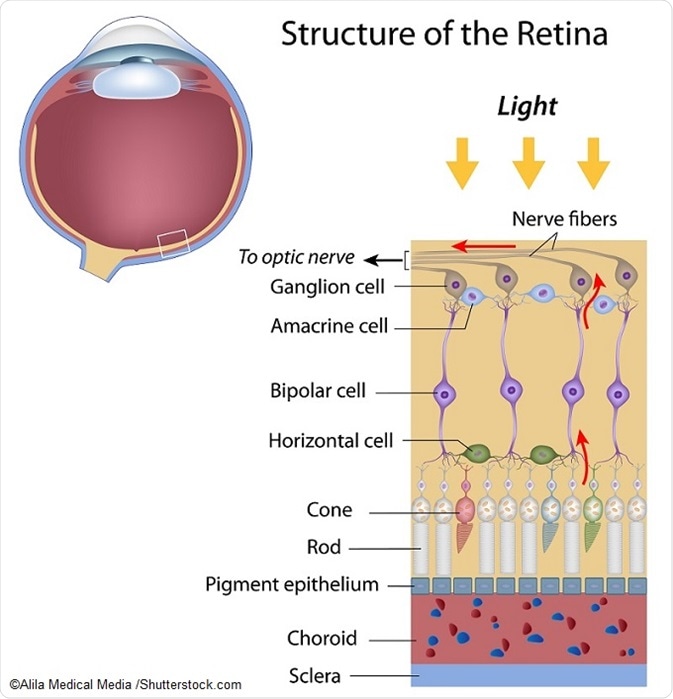The body is geared to function according to a number of inbuilt biological clocks which respond to various cues, including light and darkness. These work in coordination under the master clock in the hypothalamus, which reacts to light.
Light and the circadian rhythm
Light is perceived in the retina by image-forming and non-image forming photoreceptors. The second type includes the intrinsically photosensitive retinal ganglion cells, or ipRGCs. These are responsible for perception of light by the hypothalamic clock even in blind individuals, which in turn regulates entrainment of the circadian cycles, and produces the pupillary light response.

These cells contains a specialized photopigment, mostly thought to be melanopsin. This is responsible for mediating the circadian rhythm in humans. The circadian clock is susceptible to phase-shifting by artificial light, and blue light is the most effective for this therapy, with a shorter duration and lower radiance being sufficient to achieve suppression of melatonin. Melatonin is a key hormone in circadian regulation.
40 percent of the neural pathways that are known to originate in the melanopsin-producing ipRGCs project to the suprachiasmatic nucleus (SCN) which controls the biological clock. Sleep has been particularly well studied in relation to the circadian rhythms. The SCN secretes melatonin in a specific pattern in response to environmental light. Thus biological night causes melatonin production to rise, which triggers the onset of sleepiness. Artificial light at night, especially when timed inappropriately in relation to the biological clock, can lead to severe disturbances of the biological rhythms.
Other ipRGC axons project to brain areas which control the effect of light on physical activity, sleep duration and type re-training of circadian rhythms, and the rhythm of secretion of several hormones. These regions of the brain include the limbic system, the brainstem, and the cortex. Thus functions such as fear reactions, language, analysis, and long-term memory, are all potential targets for ipRGC-mediated stimulation or modulation. Sunlight and darkness are the primary zeitgeber or synchronizer of the circadian system in humans.
Results of circadian rhythm disruption by light
Circadian rhythm disruption by abnormal light exposures may therefore cause various metabolic and chronic conditions to arise, including tumors, diabetes, depression, and obesity, as a response to desynchronization of various physiological processes.
Shift workers are a model for this type of disorder, because their ‘unnatural’ work times have been associated with various types of morbidity and mortality from cancer and cardiovascular disease, including heart disease and strokes. Breast cancer has been declared to be in part caused by shift work, which is an identified risk factor for the condition. As a result, some governments compensate female shift workers who develop breast cancers for their medical care.
"Biological Effects of Light and What this means for Housing Design and..." by Victoria L. Revell
Blue light and circadian rhythm
In the modern world, light-emitting diodes (LEDs) are being increasingly used in all kinds of applications where light is used. These include backlit devices such as smartphones, tablets, e-readers, and computer or television monitor screens. Industrial, commercial, and domestic lighting is also dependent upon LEDs.
However, research shows that the spectrum of light emitted by LEDs is not really white but contains blue light at peak emission, in the 400-490 nm range. Blue light is used to treat many disorders, including sleep disturbances and circadian dysrhythmias, because it affects many functions of the body.
Blue light exposure is also responsible for increased alertness and cognitive function. In support of this, many studies have pointed out that the use of backlit e-readers at bedtime can cause hyper-arousal which has a negative effect on sleep. Blue light is also useful for improving alertness in shift workers. It also helps to treat seasonal affective disorders such as SAD (seasonal affective depression), and a recent interesting discovery is that mutations of the melanopsin gene can increase the risk of these disorders.
Light exposure timing and circadian rhythm resetting
A very intriguing modality of treatment of circadian rhythm disorders such as shift work insomnia and jet lag is carefully regulated and timed bright light over several days, which has been shown to produce a predictable and precise change in the circadian rhythm. It is based on the demonstrated difference in the effect of light on various physiological functions known to vary with the timing of the light stimulus, with respect to both amplitude and direction.
Thus nocturnal exposure to light has the maximum effect on the biological system, and the least in the middle of the day when sunshine exposure is maximum. The same stimulus late in the day or in the evening causes a phase delay shift. In the night or early in the biological day, it causes phase advance shifts instead.
Melatonin suppression occurs within five minutes of the start of exposure to each stimulus, but its levels began to rise within ten minutes of the end of exposure. Each light stimulus following the first one produced a similar suppression, and rise of melatonin. This pattern holds good for all animals, plants, and insects, which have a circadian system.
It follows on that short-duration treatment with blue or white light works for all these disorders, to re-entrain the circadian rhythm to a 24-hour day. At the same time, untimely light exposure can bring on a host of disorders ranging from insomnia to cognitive deficits.
References
- https://www.ncbi.nlm.nih.gov/pmc/articles/PMC4734149/
- https://www.ncbi.nlm.nih.gov/pmc/articles/PMC2831986/
- https://www.ncbi.nlm.nih.gov/pmc/articles/PMC2717723/
- https://www.ncbi.nlm.nih.gov/pmc/articles/PMC4375362/
Further Reading